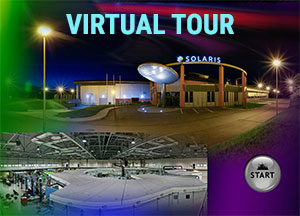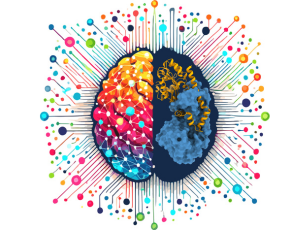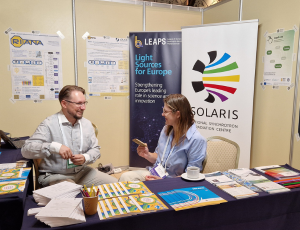 Web Content Display
Web Content Display
SOLARIS centre
 Web Content Display
Web Content Display
Summary of the year 2022
It seemed to us that after more than two years of the COVID pandemic, the situation in the world would return to relative normality. Unfortunately, the war in Ukraine caused by Russia has shown how fragile the foundations of the world order are, and the conflict taking place at the gates of Europe also has a multifaceted impact on the world of science.
Fixed points in a changing environment
In 2022, the SOLARIS National Synchrotron Radiation Center, despite many difficulties and threats related also to the instability of the energy market, invariably continued the implementation of its goals. Working with the national and international scientific community, it designed, created and made available research stations using unique experimental methods based on the properties of synchrotron radiation and electron cryomicroscopy techniques.
A constant feature of the existence of the Center as a young entity is its development. Despite the dynamics of changes taking place in 2022, both in terms of global politics and their impact on the scientific community, the trends towards evolution have been maintained. In the scale of the entire unit, an undisputed milestone this year was the start of the expansion of the synchrotron experimental hall. The enlarged building will primarily enable the launch of four more research lines, including SOLCRYS, intended for structural testing, which is already in the advanced design phase. The SOLCRYS research line will enable e.g. analysis of the structure of proteins, viruses, nucleic acids and polymers. The National Center for Electron Cryomicroscopy will also find its place in the new hall. So far, two electron microscopes - Titan Krios and Glacios - are located in laboratories built especially for this purpose, in the loading dock of the old part of the building. In the enlarged hall, an electron cryomicroscopy laboratory will be built, which will ultimately accommodate as many as four microscopes. The project also includes a sample preparation laboratory that will be available to all SOLARIS users. It will contain the necessary equipment for the preparation of samples for testing lines, as well as for the development of grids for Cryo-EM measurements. The last area that will find its place in the expanded hall is the workshop space and new offices for the expanding SOLARIS research team.
Also, the research infrastructure in the existing hall was subject to modification, both in the context of measuring instruments and communication. Conceptual work lasted for many months, crowned with a systemic change of the names of a number of lines. The common core of the new acronyms was the world science-fiction literature, thus paying homage to the work of Stanisław Lem, a kind of godfather of SOLARIS. Thus, the XAS line became PIRX, SOLABS became ASTRA, SOLAIR became CIRI, and UARPES became URANOS.
The most important thing, however, is the fact that on each of the newly built lines, work related to tenders or assembly of individual elements was underway. Particularly noteworthy this year was the ASTRA line, where in January 2022 the beginning of the start-up phase and research work with the first group of friendly users took place. The former SOLABS was submitted for the spring call for applications for research time, while on June 30 the line was officially opened. The ceremony was attended by representatives of the world of science and industry, including the Consul General of Germany and representatives of the international team involved in the creation of ASTRA. The POLYX line under construction was also successful this year. In May, after passing radiological tests of the line, it was possible to capture a beam of X-rays that hit a fluorescent screen and caused a strong emission of synchrotron light. A milestone in the construction of CIRI (formerly SOLAIR) was the availability of the FT-IR microscope for test measurements, which in July was supplemented with the last element, the Focal Plane Array detector. Ultimately, the microscope, after being connected to the synchrotron beam, will be one of the two terminal stations of the CIRI line.
Users and calls for proposals
The year 2022 was a special time. The end of the COVID pandemic, which the restrictions left their mark on the travel possibilities of the scientific community. The war going on in the neighborhood, which held our breath in this part of Europe for many months, but also the schedule for the expansion of the new synchrotron hall. All this does little to contribute to the call for proposals. In 2022, there was only one competition for research time - spring. The schedule of construction works made it impossible to announce the autumn recruitment. The International Evaluation Committee will have the opportunity to analyze a record number of applications submitted for five research lines and a cryomicroscope. In the ninth call for applications for research time on the SOLARIS infrastructure, 114 applications were submitted, which is a significant increase in the number of research groups interested in measurements compared to the previous call, by as much as 67%. For the first time, the ASTRA research line, dedicated to X-ray absorption spectroscopy (XAS), was made available in the competition procedure. 19 applications were submitted for research time on this line. The PIRX, URANOS, PHELIX, DEMETER and cryomicroscope research lines were the subject of 18, 15, 12, 20 and 30 applications, respectively.The highest goal - scientific publications
Increased interest in research at the Center and better recognition of SOLARIS among researchers in the country and abroad translated into a large number of applications for research time and an increase in the number of scientific publications on research that was carried out at the synchrotron. Among the nearly forty new publications, the article on cryomicroscopy research, published in the journal entitled "EMBO Molecular Medicine", in which researchers showed how genetic mutations in patients affect Elongator activity and lead to severe clinical symptoms. In the magazine entitled "2D Materials", users of the SOLARIS Center emphasized in 2022 the critical importance of disorder in the MnBi2Te4/(Bi2Te3)n self-assembled magnetic topological insulator, a material that is a new platform for the anomalous quantum Hall effect. This is important because this material has recently aroused the interest of scientists also due to the possibility of realizing the state of an axion insulator. Much of the research needed for this publication was carried out using the URANOS research line. The SOLARIS scientific team also worked on interesting research, as a result of which the names of our scientists appeared in over twenty publications, often in prestigious journals. Groundbreaking research allowing the creation of three-dimensional maps of the orientation of bonds in a sample has been published by the research team at the CIRI line in the prestigious journal "JACS". Summaries of selected publications are available in a dedicated "research" tab on the Centre's website.Scientific conferences and popularization
The same factors that affected the call for proposals for research time processes also affected any special events planned for 2022. Nevertheless. The SOLARIS Center constantly undertook to organize new projects in the context of popularizing not only the synchrotron and cryomicroscopy, but also, more broadly, exact sciences. These include the organization of scientific and popular science events, guided tours, activities in the field of media relations, campaigns in new media, establishing permanent forms of cooperation with other units, as well as activities ensuring access to information for people with disabilities. NCPS has been involved in 15 special events of various sizes. Among them were two scientific conferences (IBIC 2022 and User Meeting), a series of one-day meetings dedicated to representatives of the world of industry entitled "SOLARIS Industry Day", seminars on innovative IT solutions, workshops for young people, experimental shows for children, meetings summarizing international projects and guest appearances by scientists from other centres. As part of the initiatives addressed to the general public, a group of nearly 700 people gathered around the topic of SOLARIS, who took part in various events, such as Polish Science Day, Education Quality Week, Stanisław Lem's birthday anniversary, Małopolska Innovation Week and Researchers' Night. Among the basic activities of the center was the organization of trips, the participants of which were both representatives of the world of science and people (including young people) not associated with the academic environment. In this respect, 2022 was the time when the Center's infrastructure was visited by more people in twelve months than before the outbreak of the pandemic - 1,766 visitors were admitted, the vast majority of them before the expansion of the hall began. The last year saw a significant increase in the popularity of social media channels managed by the SOLARIS Centre. The total number of followers of SOLARIS social media channels in December 2022 included 3,035 followers, which is an increase of 56% of followers compared to the previous year. Care for maintaining constant communication with the recipients of articles on research and events carried out in SOLARIS takes place not only on the level of new media. The language of the scales are relations with journalists of traditional channels, such as radio, television and magazines. In 2022, SOLARIS was the subject of 45 press reports.



